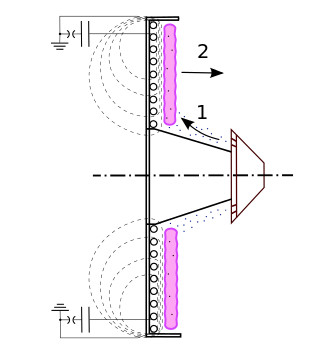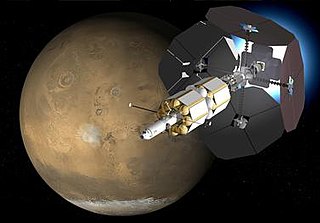Related Research Articles

Spacecraft propulsion is any method used to accelerate spacecraft and artificial satellites. In-space propulsion exclusively deals with propulsion systems used in the vacuum of space and should not be confused with space launch or atmospheric entry.

In spacecraft propulsion, a Hall-effect thruster (HET) is a type of ion thruster in which the propellant is accelerated by an electric field. Hall-effect thrusters are sometimes referred to as Hall thrusters or Hall-current thrusters. Hall-effect thrusters use a magnetic field to limit the electrons' axial motion and then use them to ionize propellant, efficiently accelerate the ions to produce thrust, and neutralize the ions in the plume. The Hall-effect thruster is classed as a moderate specific impulse space propulsion technology and has benefited from considerable theoretical and experimental research since the 1960s.

An ion thruster, ion drive, or ion engine is a form of electric propulsion used for spacecraft propulsion. An ion thruster creates a cloud of positive ions from a neutral gas by ionizing it to extract some electrons from its atoms. The ions are then accelerated using electricity to create thrust. Ion thrusters are categorized as either electrostatic or electromagnetic.

A magnetoplasmadynamic (MPD) thruster (MPDT) is a form of electrically powered spacecraft propulsion which uses the Lorentz force to generate thrust. It is sometimes referred to as Lorentz Force Accelerator (LFA) or MPD arcjet.
A pulsed plasma thruster (PPT), also known as a Pulsed Plasma Rocket (PPR), or as a plasma jet engine (PJE), is a form of electric spacecraft propulsion. PPTs are generally considered the simplest form of electric spacecraft propulsion and were the first form of electric propulsion to be flown in space, having flown on two Soviet probes starting in 1964. PPTs are generally flown on spacecraft with a surplus of electricity from abundantly available solar energy.

A pulsed inductive thruster (PIT) is a form of ion thruster, used in spacecraft propulsion. It is a plasma propulsion engine using perpendicular electric and magnetic fields to accelerate a propellant with no electrode.

The Variable Specific Impulse Magnetoplasma Rocket (VASIMR) is an electrothermal thruster under development for possible use in spacecraft propulsion. It uses radio waves to ionize and heat an inert propellant, forming a plasma, then a magnetic field to confine and accelerate the expanding plasma, generating thrust. It is a plasma propulsion engine, one of several types of spacecraft electric propulsion systems.
Field-emission electric propulsion (FEEP) is an advanced electrostatic space propulsion concept, a form of ion thruster, that uses a liquid metal as a propellant – usually either caesium, indium, or mercury.
A propellant is a mass that is expelled or expanded in such a way as to create a thrust or another motive force in accordance with Newton's third law of motion, and "propel" a vehicle, projectile, or fluid payload. In vehicles, the engine that expels the propellant is called a reaction engine. Although technically a propellant is the reaction mass used to create thrust, the term "propellant" is often used to describe a substance which contains both the reaction mass and the fuel that holds the energy used to accelerate the reaction mass. For example, the term "propellant" is often used in chemical rocket design to describe a combined fuel/propellant, although the propellants should not be confused with the fuel that is used by an engine to produce the energy that expels the propellant. Even though the byproducts of substances used as fuel are also often used as a reaction mass to create the thrust, such as with a chemical rocket engine, propellant and fuel are two distinct concepts.

The gridded ion thruster is a common design for ion thrusters, a highly efficient low-thrust spacecraft propulsion method running on electrical power by using high-voltage grid electrodes to accelerate ions with electrostatic forces.
MagBeam is the name given to an ion propulsion system for space travel initially proposed by Professor Robert Winglee of the Earth and Space Sciences Department at the University of Washington for the October 2004 meeting of the NIAC. MagBeam is different from a traditional electrostatic ion thruster in several ways, the primary one being that instead of the fuel and propulsion system being part of the payload craft, they are instead located on a platform held in orbit. It has also been suggested that the technology could be used to reduce the amount of space debris in orbit around Earth.

High Power Electric Propulsion (HiPEP) is a variation of ion thruster for use in nuclear electric propulsion applications. It was ground-tested in 2003 by NASA and was intended for use on the Jupiter Icy Moons Orbiter, which was canceled in 2005.
In electromagnetism, a helicon is a low-frequency electromagnetic wave that can exist in bounded plasmas in the presence of a magnetic field. The first helicons observed were atmospheric whistlers, but they also exist in solid conductors or any other electromagnetic plasma. The electric field in the waves is dominated by the Hall effect, and is nearly at right angles to the electric current ; so that the propagating component of the waves is corkscrew-shaped (helical) – hence the term “helicon,” coined by Aigrain.
The electrodeless plasma thruster is a spacecraft propulsion engine commercialized under the acronym "E-IMPAcT" for "Electrodeless-Ionization Magnetized Ponderomotive Acceleration Thruster". It was created by Gregory Emsellem, based on technology developed by French Atomic Energy Commission scientist Dr Richard Geller and Dr. Terenzio Consoli, for high speed plasma beam production.

A plasma propulsion engine is a type of electric propulsion that generates thrust from a quasi-neutral plasma. This is in contrast with ion thruster engines, which generate thrust through extracting an ion current from the plasma source, which is then accelerated to high velocities using grids/anodes. These exist in many forms. However, in the scientific literature, the term "plasma thruster" sometimes encompasses thrusters usually designated as "ion engines".

Spacecraft electric propulsion is a type of spacecraft propulsion technique that uses electrostatic or electromagnetic fields to accelerate mass to high speed and thus generating thrust to modify the velocity of a spacecraft in orbit. The propulsion system is controlled by power electronics.
Roderick William Boswell AM FAA FTSE is an Australian physicist. He is a professor at the Australian National University in Canberra, in the Space Plasma, Power and Propulsion group of the Plasma Research Laboratory. He invented a technology which become the basis for the development of a new type of rocket thruster, the Helicon Double Layer Thruster: the ongoing development of the Australian Plasma Thruster is supported by the European Space Agency.
Atmosphere-breathing electric propulsion, or air-breathing electric propulsion, shortly ABEP, is a propulsion technology for spacecraft, which could allow thrust generation in low orbits without the need of on-board propellant, by using residual gases in the atmosphere as propellant. Atmosphere-breathing electric propulsion could make a new class of long-lived, low-orbiting missions feasible.
A magnetic nozzle is a convergent-divergent magnetic field that guides, expands and accelerates a plasma jet into vacuum for the purpose of space propulsion. The magnetic field in a magnetic nozzle plays a similar role to the convergent-divergent solid walls in a de Laval nozzle, wherein a hot neutral gas is expanded first subsonically and then supersonically to increase thrust. Like a de Laval nozzle, a magnetic nozzle converts the internal energy of the plasma into directed kinetic energy, but the operation is based on the interaction of the applied magnetic field with the electric charges in the plasma, rather than on pressure forces acting on solid walls. The main advantage of a magnetic nozzle over a solid one is that it can operate contactlessly, i.e. avoiding the material contact with the hot plasma, which would lead to system inefficiencies and reduced lifetime of the nozzle. Additional advantages include the capability of modifying the strength and geometry of the applied magnetic field in-flight, allowing the nozzle to adapt to different propulsive requirements and space missions. Magnetic nozzles are the fundamental acceleration stage of several next-generation plasma thrusters currently under development, such as the helicon plasma thruster, the electron-cyclotron resonance plasma thruster, the VASIMR, and the applied-field magnetoplasmadynamic thruster. Magnetic nozzles also find another field of application in advanced plasma manufacturing processes, and their physics are related to those of several magnetic confinement plasma fusion devices.

Direct Fusion Drive (DFD) is a conceptual, low radioactivity, nuclear-fusion rocket engine, designed to produce both thrust and electric power, suitable for interplanetary spacecraft. The concept is based on the Princeton field-reversed configuration reactor, invented in 2002 by Samuel A. Cohen. It is being modeled and experimentally tested at Princeton Plasma Physics Laboratory, a U.S. Department of Energy facility, as well as modeled and evaluated by Princeton Satellite Systems (PSS). As of 2018, a direct fusion drive project driven by NASA is said to have entered its simulation phase, presented as the second phase of the concept's evolution.
References
- ↑ J Ling; M D West; T Lafleur; C Charles; R W Boswell (2010). "Thrust measurements in a low-magnetic field high-density mode in the helicon double layer thruster". Journal of Physics D: Applied Physics. 43 (30). IOP Publishing. Bibcode:2010JPhD...43D5203L. doi:10.1088/0022-3727/43/30/305203.
- 1 2 "Testing ground set for plasma jar to the stars". ResearchCareer. March 11, 2014. Retrieved July 19, 2016.
- ↑ "Wombat puts electric rocket through its paces". Stories of Australian Science. May 16, 2014. Retrieved July 19, 2016.
- ↑ "HDLT Applications". Plasma Research Laboratory. Archived from the original on March 2, 2011. Retrieved July 19, 2016.
- ↑ Tarantola, Andrew (June 13, 2012). "Australia Is Building a Pee-Powered Ion Thruster". Gizmodo. Retrieved July 19, 2016.
- ↑ "How long would a trip to Mars take?" . Retrieved July 19, 2016.